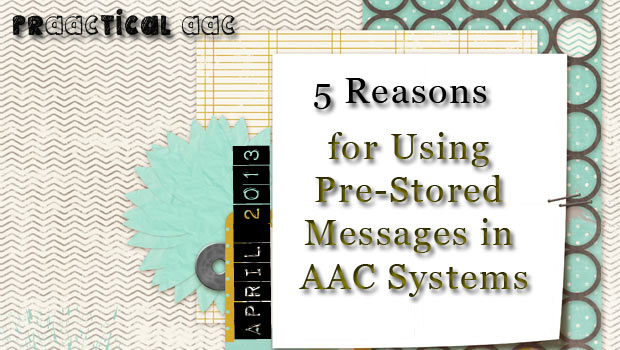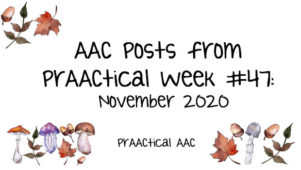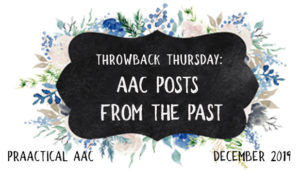5 Reasons for Using Pre-Stored Messages in AAC Systems

Although we are deeply invested in AAC systems that have a robust set of core language, that doesn’t mean we insist that our clients generate sentences word-by-word all the time. There are lots of good reasons for pre-storing longer messages. Here are some of them.
-
Emergency messages: When we’re communicating about things like spasms, seizures, pain, medication, fear, and danger, time is of the essence. The quicker, the better.
Examples: “My asthma is kicking up. Get my puffer, please.” “I’m having a back spasm. Take me out of my chair.” “I think my sugar is off. Can you do a finger prick to check my levels?” “I’m scared. Can you help me?”
-
Partner instructions and communication transaction messages: Sometimes we communicate about communicating. In AAC, it’s not uncommon for someone to set the stage for how the interaction will proceed or provide their partner with specific directions. When communicating to make the business of interaction run more smoothly, we want to make the process quick and easy.
Examples: “Wait. I have something to tell you.” “Ask me a yes/no question about it.” “It’s not on my board.” “I need a minute. Thanks for your patience.” “Say the letters out loud as I spell.”
-
Discourse functions: Conversations proceed at a pretty quick pace, and without some prestored messages, some people who are learning AAC can be left behind. We often prestore messages that help the communicator initiate, maintain, redirect, or terminate an interaction,
Examples: “Excuse me, do you have a minute?” “I’m not sure I agree.” “That’s what I was thinking.” “I’m going to switch topics.” “I’d better get going.” “Nice to see you again.”
-
Questions: We love to put the magnetic power of questions into the hands of AAC learners. Many individuals with whom we work are learning to create novel sentences and, for others, a single word can suffice. There are times, though, when having a pre-stored question can accelerate the learning and active participation
Examples: “What do you think?” “Can you explain that?” “When will I see you again?” “What is going on? “Why is that happening?”
-
Predictable routines: When events/activities happen in a similar fashion in each time, the nature of the routine allows us to predict some messages that might be useful . Offering a few pre-stored options can help AAC learners communicate within those routines relatively quickly and without extensive support.
Examples: The Pledge of Allegiance, “I’m here to get the mail for Room 108, please.” “School Chant, Scout Promise
We use pre-stored messages cautiously, and always in addition to (never instead of) word-based vocabulary that allows communicators more control over their interactions. Not every person wants or needs pre-stored messages, but for some it’s a prAACtical option.
Filed under: PrAACtical Thinking
Tagged With: pre-stored messages, vocabulary, vocabulary selection
This post was written by Carole Zangari




